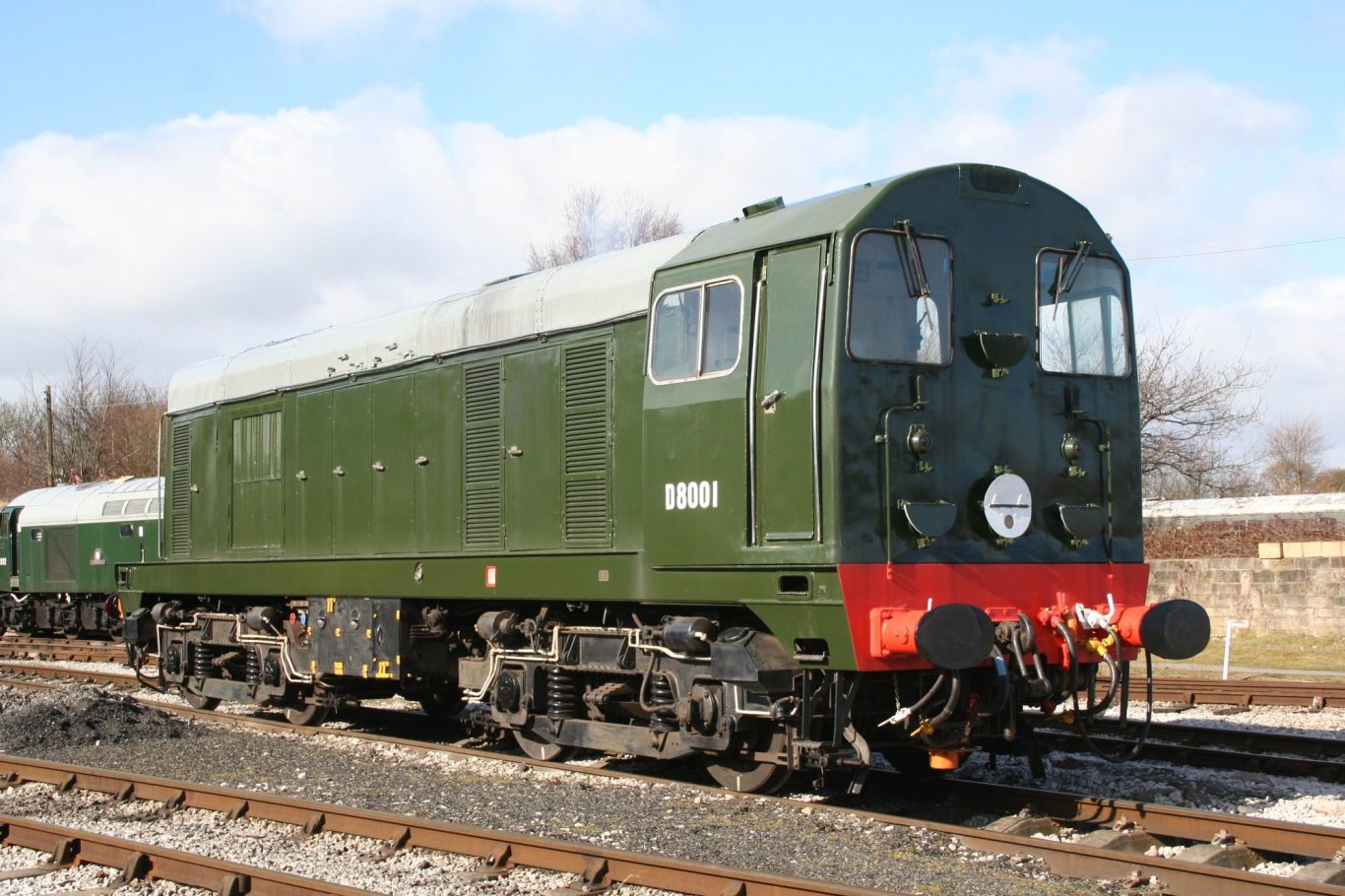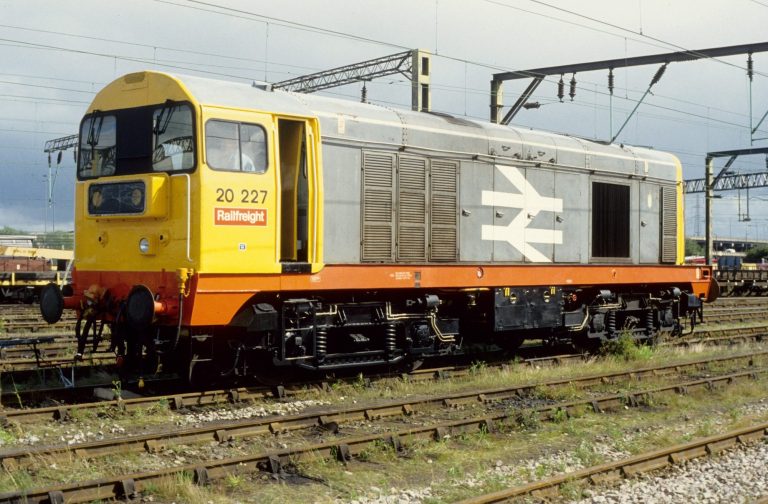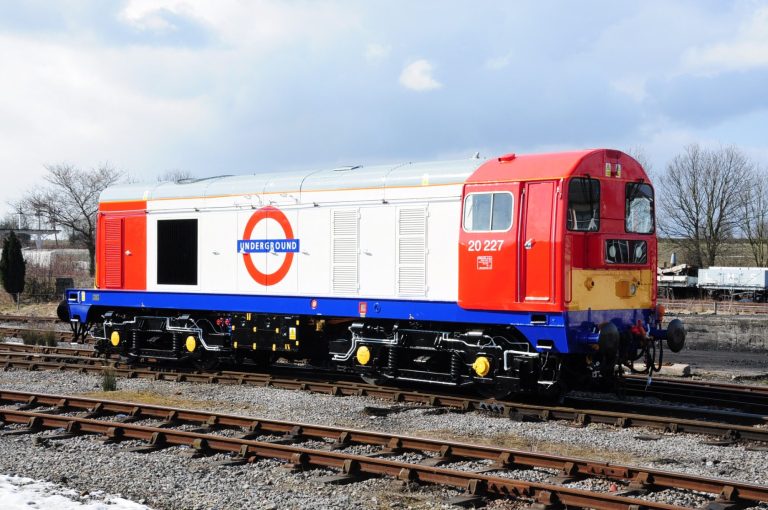
Our Locomotives
D8001/ 20001
Built as D8001, this Loco is the second of the Class built in 1957. 001 spent many of its BR Service years based at
Toton Depot working merry go round coal Trains. Currently based at the Epping & Ongar Railway the loco has recently undergone
extensive restoration and an engine overhaul. After a few winter repairs we hope to have 001 in action again during the spring.
Status: Operational visiting the Great Central Railway.
D8001 was delivered new from Vulcan foundry to Devon’s Road Bow in July 1957 after numerous test trains up the west coast main line to Penrith. As the second locomotive in a pilot scheme of 20 locomotives, the locomotive was delivered in all over green, red buffer beams and oval buffers, the new type 1 locomotives being an instant success working local freight trips around East and North London. In September 1958 reallocation to Crewe occurred until a transfer back south to Willesden in October 1960, saw 001 working amongst the trip freights, station pilot and ECS turns out of Euston and even the occasional passenger turn on the local services from Euston to Tring. In October 1969 001 moved to Toton followed by reallocation to Tinsley a year later in October 1970, used predominantly on coal trains. There then followed a move north of the border to Haymarket in 1971 which was to be short lived as 001 moved back to Toton in March 1973 and in March 1974 whilst allocated here was allocated the TOPS code 20001.In July 1975, 001 was placed into stored serviceable status at Westhouses for a couple of months, before a return to service in October of that year back on coal trains. It was back to Tinsley again in November 1978. In early 1980, 001 entered Glasgow works for a general classified overhaul, returning to traffic in March.
In mid 1984, the fitting of dual brakes and slow speed control was undertaken upon which a return to Toton for MGR work took place in September followed by a brief spell based at Bescot. During 1985 Toton starting semi permanent pairings for 20’s and 001 was paired for some time with fellow pilot scheme 20016, but in 1988 001 was finally withdrawn from BR service and used as a Toton training locomotive, on paper numbered ADB968029, but never displayed on the loco. The loco was repainted in 1989 and supplied for the midland railway gala and it was at this event the CTLS attempted to purchase 001, unsuccessfully. 001 returned to Toton and was housed under cover in the test house and was well cared for, joined for a short while by 20032 until reinstated. 20227 then joined 001 in the training pool and after many months was finally purchased by the CTLS in November 1991, moving to the MRC at Butterley and into preservation. In 1992 work beckoned again, this time working CTRL wiring trains as part of a pool of Class 20’s on hire to RFS. This was a prestigious contract for the CTLS and the revenues helped pay for a full bogie overhaul after return to preservation. 20001 has remained based at the MRC Butterley, but has visited many lines for galas and spent some time at both the Ecclesbourne Railway and more recently the Epping and Ongar. Every penny of cash we earn is ploughed back into maintaining 001 and has recently had some tlc, with a power unit overhaul, main generator overhaul, cab refit, extensive cab steel replacement and a repaint into green.
D8327/ 20227
Built as D8327, our first Loco purchased was the last built. 227 spent most of its BR Service life working in Scotland where the last batch of Loco's were sent. Currently this Loco Sports a revised London Underground Livery.
Status: Currently Operational (Epping & Ongar Railway).
Life started in February 1968 when newly built D8327 was delivered from Vulcan foundry to Polmadie shed in Glasgow. Being the final loco of the English Electric type 1 scheme it was built from new with dual air and vacuum brakes and also fitted with a newly developed slow speed control system. Shortly after, 8327 (with the D prefix now dropped) moved to Haymarket depot to work Fifeshire and Lothian coal trains and in December 1973, 8327 was renumbered to 20227. Apart from this, very little out of the ordinary happened for 15 years until a downfall in work brought about by the miners strike of 1984 causing 20227 to be reallocated south to Toton in Derbyshire. In March 1985, all the locos sent down in 1984 were sent back north of the border, 20227 was therefore sent to Motherwell, but got reallocated twice in the same month first to Glasgow Eastfield and then "back home" to Haymarket. At the end of summer 1985, 20227 entered Glasgow St Rollox works for a classified intermediate overhaul, emerging in October in the then new yellow, grey and red Railfreight colours. This was 227's first change of livery having been blue since delivery. 20227 travelled to Toton in May 1988 and remained paired up until July 1989 with 20193, then in turn 054, 188 and 095 until they were all condemned!
20.227's use on passenger trains before 1984 was sparse. But wishing to make up lost ground then put in a variety of performances, Skegness numerous times in 1984, a number of rescue jobs in Scotland in 1986 and 1988, Derby Crewe/Skegness trains in 1989 and appearing on Gloucester open day shuttles also in 1989. During a brief spell at Bedford during 1989 as a training loco, even venturing out ‘single’ on the Bedford – Bletchley service after a DMU failure and finished off 1990 on the famous Derby – Matlock top and tail trains, with the culmination of the BR passenger days happening in September 1990 with a blast to Skegness and a trip to Lincoln. Three weeks later 227 was condemned in October 1990.
Although 227 failed in BR service a few times, mainly due to electrical faults, it was actually a very reliable loco and condemnation was not on grounds of any defects, purely lack of work. 227 was moved to the training area at Toton along with sister 20001, with transfer to the Class Twenty Locomotive Society happening in September 1991 and after a freshen up of the Railfreight livery and carried the name ‘Traction’ for a while.
20227 has continued to provide good service to the industry and has probably had the most varied career of any preserved locomotive, from crash testing of coaching stock in 1990 at Derby RTC, LU track renewal work during 1993 , channel tunnel wiring trains, Yorkshire RHTT trains in 2011 to S stock delivery trains in 2012. It was the 1993 track renewal work that started a close relationship with London Underground, with 227 being used since in top and tail mode on heritage trains for many years and the history making ‘Metronome’ tour on the Metropolitan lines where 227 was the first preserved locomotive to operate ‘main line’ post privatisation, painted in heritage maroon livery to match Sarah Siddens and named ‘Sir John Betjeman’. In recognition of the London Underground 150 year anniversary in 2013, 20227 was painted in modern LU livery which she wore until 2017 when she was repainted into a heritage LU livery in similar style to the LT Electric Locomotives, and named ‘Sherlock Holmes’.
Many people forget that although mainline certified, it is a ‘preserved’ locomotive and every penny of cash we earn is ploughed back into maintaining 227 along with our other locomotives and stock. The core 10 members give up hours of their time, repairing, maintaining and managing main line activities, not taking a penny from the society. She has fully overhauled bogies, a fully overhauled engine, generator, TPWS, OTMR, GSM-r and of course now a full body overhaul and repaint; and is a credit to the whole team as our flagship locomotive.
8305/20205
Life started when newly built D8305 was delivered from Vulcan foundry to York shed in April 1967, along with the batch D8300-D8309. Being one of the final batch of the English Electric type 1 scheme she was built new with dual air and vacuum brakes and also fitted with a newly developed slow speed control system. In May 1971, 8305 (with the D prefix now dropped) moved to Tinsley shed where TOPS renumbering to 20205 occurred in February 1974. It was in December 1976 that 20205 headed to Scotland initially allocated to Eastfield (ED) but moving in May 1978 to Haymarket depot (HA) to start a long relationship with the Fifeshire and Lothian MGR coal trains. After a brief time in store in 1983, 20205 was then reallocated back to ED in September 1986, before moving back south of the border in March 1989 to Thornaby (TE). After a brief stay, paper allocation to Toton (TO) came in November 1989 and then immediately to Immingham (IM) one month later in December 1989, with final withdrawal coming shortly after on the 18th December 1989 at Frodingham depot (FR).
20.205's use on passenger trains was quite significant in the early years when based at York, working portions to Scarborough, however then recorded only a handful of workings in the next 18 years, confined to rescue turns and Carstairs portions with one run out as the pilot trip to Ayr.
After withdrawal, 20205 was initially sold in October 1994 to Pete Waterman and was moved to MC Metals in March 1995 for asbestos removal, with subsequent sale to the Class 20 Locomotive Society that same month and movement by road to the Midland Railway Cetre occurred in April 1995. 20205 was in open store for over 18 years, with minor work being carried out to preserve the mechanical condition of the loco, and was even painted in DRS blue and renumbered 20907 for the 50th celebrations, but with commitments to 20001 and 227 taking up the time of the small band of volunteers, 20205 became a static exhibit and spares Christmas tree. This all changed in 2014, when Michael Owen approached the CTLS about a shared arrangement for funding and returning to the mainline, which has seen 20205 undertake one of the most comprehensive overhauls ever achieved in preservation in such a short time frame, a credit to the dedication of one person and a small support team. This culminated in a return to the mainline in February 2015, just over 25 years after withdrawal from British Rail use.
Many people forget that although mainline certified, ultimately 20205 is a ‘preserved’ locomotive and any profit made is used to pay off the overhaul costs and the running costs for main line use. The core 10 members give up hours of their time, repairing, maintaining and managing main line activities, not taking a penny from the society. The locomotive today has fully overhauled bogies, a fully overhauled engine, generator, auxiliaries, cab, air system, electrics TPWS, OTMR, GSM-r and of course a full body overhaul and repaint.
S
For further information and up to date goings on - Please visit our Facebook Page
class 20 locomotive society
Site Updated 06/08/2023 - Donate Button added
We need your consent to load the translations
We use a third-party service to translate the website content that may collect data about your activity. Please review the details in the privacy policy and accept the service to view the translations.







